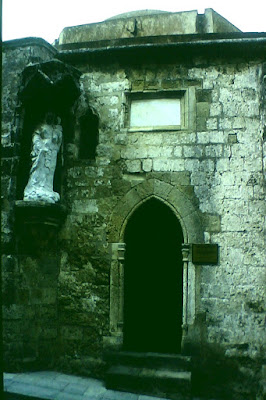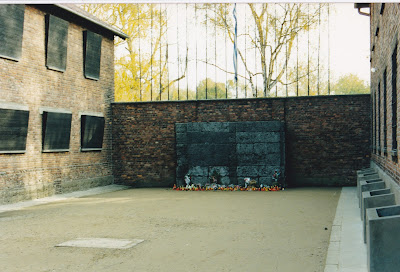I visited
Rhodes with a school party several years ago. This is a report.
Originally there were three ancient
Greek cities on Rhodes: Kamiros, Ialyssos and Lindos (the third being the only
one we visited, and the only one with significant archaeological remains from
the classical period), but in 408 BC the three came together and built the new city
of Rhodes on the northern tip of the island. It soon became a great trading
centre, with a population much bigger than today.
Everyone knows about the Colossus
of Rhodes; a gigantic statue of the sun-god Helios; one of the “Seven wonders
of the world”, though no-one knows what it looked like, or even exactly where
it stood, though imaginative Renaissance drawings of it straddling the harbour
are highly improbable. It was erected to commemorate Rhodes’s survival in a
siege by Demetrios in 304 B.C. in the wars that followed the death of Alexander
the Great. It was said to be 35 metres tall, made all of bronze, the work of
the sculptor Chares of Lindos, but it survived no more than 70 years before
collapsing in an earthquake in 227 B.C. To the Romans, and indeed to most
Greeks, it would be known only as the monstrous ruins which lay untouched on
the site for more than eight hundred years.
Rhodes attempted to remain neutral
in the wars between the Hellenistic states and the rising power of Rome, but in
164 B.C. became a “permanent ally” of Rome, and its independence was
effectively at an end. It was for centuries a centre of learning, famous for
its schools of philosophy, rhetoric and science: Cicero studied there, and
Tiberius, the future Roman Emperor, spent several years studying on the island.
But the artistic glory of Rhodes never recovered from when in 44 B.C. it was
pillaged by Cassius (famous as one of the assassins of Julius Caesar) who stole
most of its treasures and slaughtered many of the inhabitants.
For centuries Rhodes was contested
between the Byzantine Empire and the Arabs. It was in the seventh century A.D.,
during a period of Moslem occupation, that the remains of the Colossus were
finally removed by the Arabs and sold to a Jewish scrap-metal dealer. It is
said that 125 tons of bronze were taken away, loaded onto 900 camels. Today no
trace remains.
Rhodes town today bears little
remembrance of classical times. It is far more redolent of the Middle Ages, because
for 200 years it was the centre of the Knights of the Hospital of St. John of
Jerusalem, an order of fighting monks left over from the Crusades. The Grand
Master of the Hospitallers, Foulkes de Villaret, bought the island in 1309 and
turned it into a base against Islamic forces. The Old Town of Rhodes is still encircled by
vast ramparts and a triple moat built by the Hospitallers,
enclosed within which is a real
rabbit-warren of tiny alleyways and heavy stone buildings. Some of the main
streets have arches over them.
Only a few parts have been taken over by tourist
shops; the rest can scarcely have been changed for centuries. The most famous
street is the Hippoton, where the Knights lived,
with each “tongue”, or nationality, of the Order having its own “inn”, marked by distinctive coats of arms.
with each “tongue”, or nationality, of the Order having its own “inn”, marked by distinctive coats of arms.
In 1522 the forces of Suleiman the
Magnificent, the greatest of the Ottoman Sultans, launched an attack on Rhodes.
A stout defence reduced the Hospitallers to just 180 knights, at which stage
they surrendered and were allowed to withdraw to their new base of Malta,
though many of the native Rhodians were slaughtered. The Turks then ruled
Rhodes for the next four centuries, and their era is marked by the occasional mosque and derelict burial ground.
The population of Rhodes was mostly Greek, but it was not joined with the newly-created Greek state in the 19th century. Instead in 1912 Rhodes was seized by the
Italians in a war with the disintegrating Turkish Empire (as was Libya at the
same time). Much of old district, particularly the Palace of the Grand Masters,
was aggressively restored by Mussolini during the period of Italian occupation.
I found a plaque commemorating restoration work done “in the 13th year of the Fascist Era”. According to our guide, the locals still hate the Italians even more than they do the Turks, which must be something of a record for Greeks anywhere.
I found a plaque commemorating restoration work done “in the 13th year of the Fascist Era”. According to our guide, the locals still hate the Italians even more than they do the Turks, which must be something of a record for Greeks anywhere.
There used to be a large Jewish
colony in Rhodes, dating back to the earliest years of the Christian era, and
Mussolini ignored them as long as he ruled. But when the Germans took over in
1943 after Mussolini’s overthrow, all the Rhodian Jews were rounded up and sent
to Auschwitz. The train journeys across the Balkans took so long that most of
them were dead of starvation before they arrived.
In 1947 Rhodes was at long last
reunited with Greece.
We stayed at Faliriki, a popular
resort on the east coast. Our hotel was mostly occupied by middle-aged Germans,
who insisted on wearing the most unsuitably brief bathing costumes. Most of the
island looked typical of rural Greece: very rugged and barren (though with lots
of wild flowers in spring), some primitive little villages and towns with
brightly painted walls, and the ubiquitous reinforced concrete skeletons of
partially built hotels and apartments. As well as visiting Rhodes town, we had
a day in Lindos, now a little seaside town with steep cobbled streets nestling
beneath a towering acropolis. This was converted into an impregnable fortress
by the Hospitaller Knights,
but still contains parts of a classical temple to Athene and propylaea. These were swathed in scaffolding for our visit, but there was a fine view from the top.
but still contains parts of a classical temple to Athene and propylaea. These were swathed in scaffolding for our visit, but there was a fine view from the top.
Our trip coincided with the Greek
Easter, and on the Saturday evening we went into the cathedral in Rhodes town
for the service. This proved very strange. There was an incomprehensible and
interminable litany chanted amidst deep gloom, during which more and more
people pushed their way in with little sign of reverence. At 11.45 pm the
archbishop and other priests suddenly emerged from behind the iconostasis,
presumably to proclaim the Risen Christ, because the chandeliers suddenly
blazed, lights were transmitted from candle to candle, and everyone processed
out to the square, where the service resumed under a canopy. Precisely at
midnight rocket flares were launched, fireworks were set off, the police band struck
up, and all the ships in the harbour sounded their hooters. I believe the
service continued, though of course nobody could now hear a word.
On the last night we staged a fancy
dress party. The Germans in the hotel had annoyed us by complaining about the
noise, and one of the boys decided to disguise himself as Hitler. With a false
moustache and carefully combed hair he managed a remarkable resemblance: so
much so that he lost his nerve at the last moment and had to cross the foyer
pretending to read a newspaper close to his face. This was the only
disappointing moment on our holiday.

























